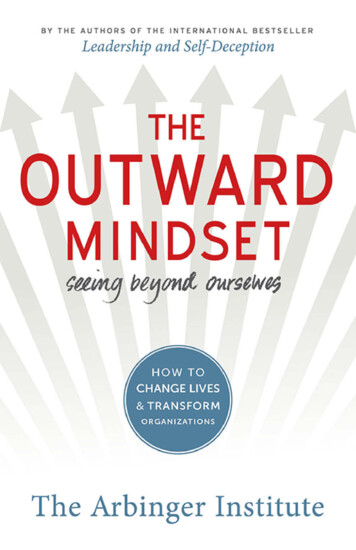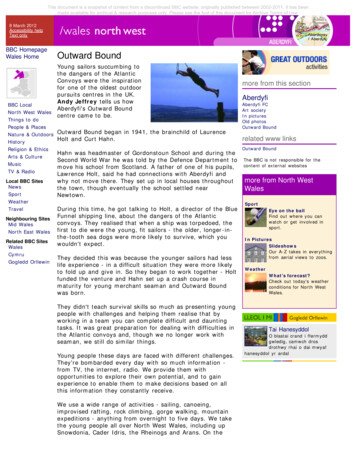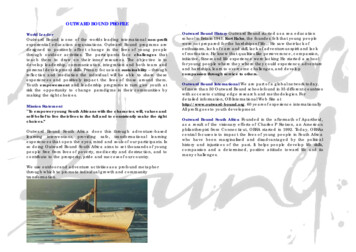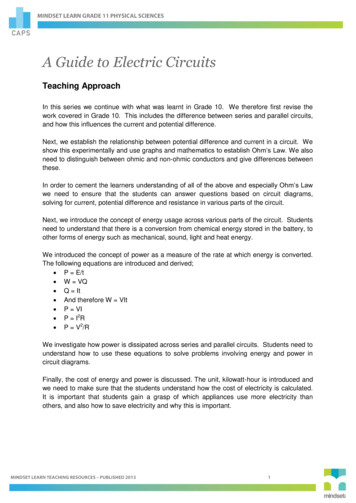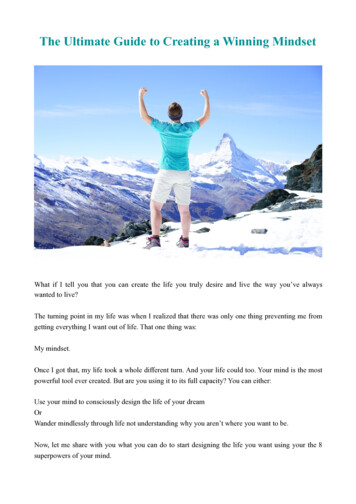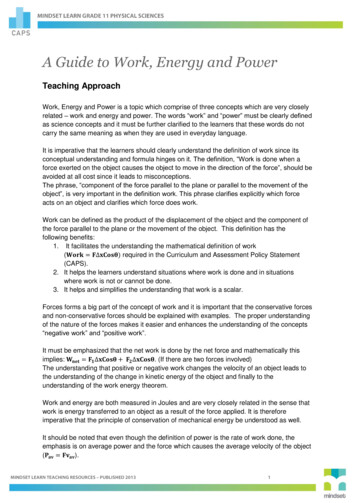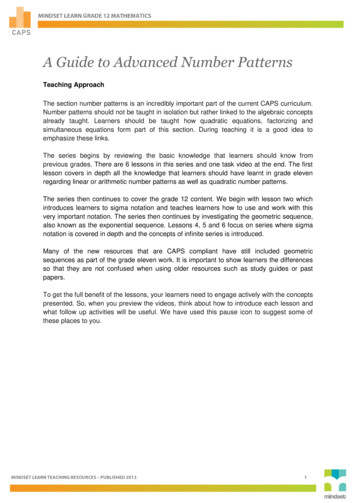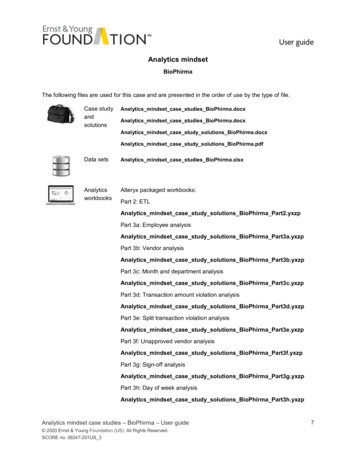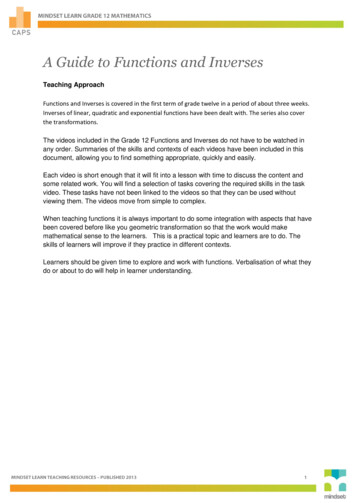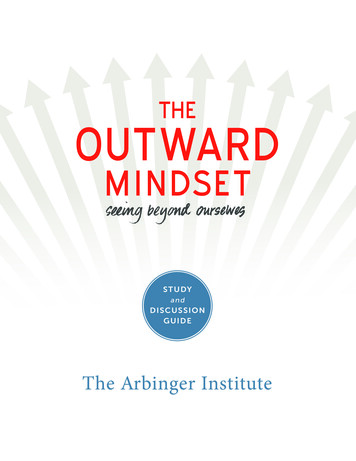
Transcription
THEOUTWARDMINDS ETS T U DYandDISCUSSIONGUIDE
THEOUTWARDMINDSETStudy and Discussion GuideThe reflection and discussion topics and questions provided here can be used to enrichindividual and group study of The Outward Mindset, by The Arbinger Institute. Reading,pondering, and discussing the book, you can experience an inner change taking place—in thought patterns, assumptions about situations in your life, views of yourself and others, and in your optimism and plans for the future. The process can be enhanced as youreflect on, write about, and/or discuss the items that follow, or any other questions orinsights you’re interested in.If you are working alone, you can begin with the reflection questions and then ponderthe discussion prompts by yourself, possibly writing your thoughts in a journal. (We highlyrecommend the use of a study journal to record thoughts and responses.) If you are ina discussion group, it’s best in many cases to start by spending a few minutes on the reflection questions individually and then to talk as a group about the discussion prompts.Discussing the reflection questions may also be helpful to the group. Depending on theneeds and desires of your group, you can take on one chapter and its discussion pointsper meeting or move at a faster pace. However, we encourage you not to rush. There ismuch to be learned and discovered through rich pondering and discussion.At all times, we at The Arbinger Institute are available to help you with your learning experience. If you wish to go beyond the items discussed in the book or in these reflectionand discussion topics, or if you would like personal or organizational help in implementing these ideas, please contact us at 801-447-9244. You may also reach us via email at:help@arbinger.com.COPYRIGHT 2016 Arbinger Properties, LLC. All rights reserved in whole or in part in all forms of media throughout theworld. No part of this book may be copied, reproduced, transmitted, or delivered in any form or by any means, includingphotocopying, recording, or other electronic or mechanical methods. Any reproduction of this handbook in whole or inpart is a violation of federal copyright and is prohibited. Violation of the copyright held herein subjects the infringer tocivil and criminal penalties, including statutory damages and applicable fines.This book must not be used to provide commercial training. The Arbinger Institute expressly prohibits groups or individualsfrom integrating the concepts presented in this course in any third party presentations, consultations, products, orservices. Any person receiving these materials agrees to comply with these conditions.Arbinger, the Arbinger logo, and The Outward Mindset are trademarks of Arbinger Properties, LLC.
A DifferentApproach1Chip HuthCaptain & Former Sergeant, KCPDReflectionThink about two times when you found yourself facing a challenging problem—onetime when you were successful in solving the problem and one time when youweren’t. For both situations, make a list of answers to the following questions: Whatwere you thinking as you approached the situation? What did you do in an attemptto resolve the problem?DiscussionOn pages 7 and 8 we hear the incredible story of Chip Huth’s transformation. Whatdo you believe made this transformation possible? What do you like the most aboutChip's story?What ShapesBehavior2ReflectionWrite down a result you are currently pursuing, whether it be at home, at work, orin some other environment. Then list the things that are currently holding you backfrom fully achieving the results you desire. From this list, identify the items thatmight relate to mindset.DiscussionDiagram 3 on page 18 and Diagram 4 on page 19 depict two very different ways ofattempting to achieve results. Discuss an experience when you attempted to accomplish something by pushing for behavior change alone. Discuss the difference itmight make if you attempted to accomplish that same task by working on a changein mindset. ArbingerArbinger Properties,Properties, LLCLLC
3TwoMindsetsLouise FrancesconiFormer President, Raytheon DivisionReflectionThink about a time when you have operated with an inward mindset. Then thinkabout a time when you have operated with an outward mindset. Write down thedifferences between both experiences.DiscussionLouise Francesconi was faced with an incredible challenge. Discuss the key reasonsLouise and her team were able to turn their seemingly impossible situation around.Relate their experience to any issues that you are currently facing.4What ShapesBehaviorReflectionThis chapter discusses the important connection between our mindset and how wesee others. Write down a time when youwere seen as an object. How did that impact you? Then write down a time whenyou were seen as a person and describe theimpact that experience left upon you.DiscussionIvan Cornia Arbinger Properties, LLCTurn to the story of William and Ivan Corniaon pages 33 and 34. How was Ivan’s fatherable change the way he saw his son and hislivelihood? What kind of influence did William Cornia have once he changed the wayhe saw and thought about the people andcircumstances in his life? In what ways areyou like William Cornia before he changed? Arbinger Properties, LLC
Getting Out ofOur Own Way5Chris WallaceReflectionAre there people in your life that you often find yourself resisting? Are there peoplethat you are often responsive to? List the key differences in the ways you feel and actaround these people. Reflecting on Chris’s story on pages 39-46 and the discussionof justification on pages 46-49, identify someone you currently feel justified toward.DiscussionIn the compelling story of Chris’s struggle with his father, what made Ann capableof influencing change? When she listened to Chris tell his story, where was herfocus? Think about and discuss ways you can focus more on others in your workenvironment (or in any environment). Discuss the ideas on justification on pages46-49. Where and in what circumstances do you find yourself getting caught up inthe need to be justified?6The Lure ofInwardnessReflectionThink about your life at work and at home. Whose needs and objectives are youoften focused on? Do you exhibit an inward mindset in any of your relationships?When you have this mindset, how does that impact the relationship?DiscussionDiagram 10, found on page 56, outlinesan “outwardly-nice” inward mindset style.Discuss times when you or your organization have exhibited this style. In thestory on page 58, Anna’s father realized“I was doing what I wanted to do withthem; I wasn’t paying attention to whatthey wanted to do.” How does this style ofinward mindset fake us out? Where do wesee it in ourselves? What is the eReports ArbingerArbinger Properties,Properties, LLCLLC
7The Outward Mindset SolutionReflectionThink about the times in your life when you were the most alive and engaged. Whoand what were you focused on in those moments—on yourself or something bigger than yourself? Visit page 60 and look at Diagram 11. Make a list of the objectives,needs, and challenges that belong to those in your sphere of influence. (For somethis might be your manager, coworkers, peers, and reports; while for others thismay be your spouse, your children, and your friends.) Evaluate how you are helping these people accomplish and face their objectives, needs, and challenges andmake a list of ways that you can improve.DiscussionCFS2, a debt collection company mentioned on page 62, has a rate of collectionthat is twice the rate of any other firm in the industry. Discuss how this companynoted the objectives, needs, and challenges of their customers. Why did the outward mindset of the CFS2 company make them more successful? What could welearn from what CFS2 did?The OutwardMindset Pattern8ReflectionThink of someone you know who alwaysseems to work with an outward mindset.What makes him or her stand out fromother people? The book teaches threesteps that help one operate with an outward mindset (page 69). Pick the relationship in your life that is the most challenging at the moment. Write the name of theperson and underneath the name fill inyour answers to those three steps.DiscussionThe book tells the story of the Ford company’s ability pull itself out of its trouble.What were some of the key events thatled this company to rise out of the “deepditch” it was in? Alan Mullaly, the CEO atFord, stated, “you aren’t red.the issueyou’re working on is red.” What differencedoes it make in our relationships with others when we separate the person from theproblem? What can we change to gain agreater sense of helpfulness toward thosethat surround us?Alan MulallyFormer CEO, Ford Motor Company ArbingerArbinger Properties,Properties, LLCLLC
9Applying theOutward Mindset PatternReflectionThink about the three steps of teh outward mindset pattern:see others, adjust efforts, measure impact. What makes eachone important? Based on your reading, why do these stepshave the potential of significantly improving performance?DiscussionHow did the team charged with creating the next year’s budget learn to see others? In what ways did Terry Olson adjust hisefforts? What were the results of Charles Jackson measuringhis impact? Apply these stories to your own situations.10Don’t Wait onOthersReflectionReflectionThink about some of the challenges that you are currently facing. In any of them, do you find yourself waiting for someoneelse to change? In regards to that challenge, make a list of theways that you may be a problem.DiscussionDiscussionOn page 101 the book states that “being able to operate withan outward mindset when others do not is a critically important ability. It is the most important move.” Why is it the mostimportant move? In the example of Tubular, Jack, Larry, and Altook the initiative to change their efforts instead of waiting onothers to change. Discuss the impact their willingness to takeaction had upon other people in the company. What can welearn from their examples?Larry HeitzFormer President & CEO, Tubular Steel Arbinger Properties, LLC
Start withMindset11Chato Villalobos , Kansas City Police Officerand students on the west sideReflectionAre you engaged in situations where you are currently attempting to change behavior in order to achieve results? If so, list ways that you can first work to changemindset.DiscussionWhat elements in the Matt, Lynda, and Chato story in Chapter 11 are examples ofstarting with mindset? What might starting with mindset mean in our own situations?ting by fars the mostntfully andorld.” Arbinger Properties, LLCKansas City’s West Side Arbinger Properties, LLC
12Mobilize Around aCollective GoalReflectionWhat is the power of building your actions around a collectiveresult even if one doesn’t already exist in your organization?Revisit the lists you made in the reflection section of Chapter 7.Based on the questions found on pages 119 and 120, take theexercise a step deeper. For each of the areas you already analyzed, ask yourself why that person is attempting to achievethose objectives. In what ways can I measure whether they areactually helped by my efforts?DiscussionIs your organization focused on pursuing a collective result?How so? If not, discuss what you can do to create a framework that is focused on a collective result. Many of the storiesincluded in this book are examples of organizations that shifted from a focus on individual results to a focus on collectiveresults. Together list some of these organizations and discusshow they were able to accomplish this.13Allow People to beFully ResponsibleReflectionReflectionWhy is it important for people to be involved in planning andexecuting their work? Both at work and at home, in what wayshave you been content just to plan or just to execute? Diagramyour own role as illustrated in Diagram 16.DiscussionDiscussionIn the story on pages 121-123, what was the impact of including the children in the planning? Why is it important to includeas many people as possible in the formation of a collective result? Pages 123-126 describe how Dan Funk learned to see andwork with a number of individuals within his healthcare organization. How does he help them to become more self-managing and self-accountable? Discuss steps that you can take tohelp yourself and others in your life do the same. Arbinger Properties, LLC
CHAPTER 14Shrink Distinctions14ReflectionWhen have you experienced the trappings of difference? How did this impact yourrelationship with those on the other side of the spectrum, whether it be higher orlower than you? What are the effects of segregation within our organizations? Thinkof ways that you can bridge the separations that exist within your organization.DiscussionAs the sports division of Madison Square Garden did (page 136), think about thepeople in your organization who most likely feel as though they are being seen andtreated as objects. Who are they? Why do they feel this way? What can be done tohelp them feel that they are being seen as equals—as people with objectives, needs,and challenges of their own that matter?Getting Out ofOur Own Way15ReflectionPonder the diagrams located on pages 142-143. Have you ever been in an organization whose systems and processes invited an inward mindset (Diagram 18)? Whatwas your experience in that organization and with those processes? On the otherhand, have you ever been in an organization whose systems and processes reflected Diagram 19? What was your experience in that organization? What becomespossible when an organization operates with systems and process tht are outwardin nature?DiscussionOn page 151 a comparison is made between the company named Landa and theorganization named Hope Arising. Discuss key differences between the two organizations and how they measure success. Which one would you rather work for?Why? Are the success metrics in your organization more inward or more outward?How can having an outward-mindset approach become a competitive advantage?Hope Arising Team Membersin Dera, Ethiopia Arbinger Properties, LLC Arbinger Properties, LLC
The RoadAhead16Mark Ballif and Paul HubbardCo-Founders and Co-CEOs, Plum HealthcareReflectionWhat sticks with you as you think back on your reading and pondering of the book?What things do you take away as things you want to do differently in your work life?Your home life? With others? What do you want to change about yourself? Whatkind of impact do you want to leave with others?DiscussionUse this opportunity to think together about all that you have discussed. This chapter uses the story of the young professional, Mark, to bring out the heart of theoutward mindset in the following question: What can I do to be more helpful? Consider: How can this principle be applied in our workplaces? How can it be appliedin our homes? What would be different in all of these contexts if we were to applythese ideas? What do we need to do?We hope you have enjoyed using this study and discussion guide. Wehave provided additional resources online, including a mindset audittool that enables you to discover the degree to which you and yourorganization may be operating from an outward mindset. Additionally,many of the people we have written about in this book have graciouslyallowed us to film them and their organizations. If you would like tolearn more from them, you can watch them share the details of theirexperiences at www.theoutwardmindset.com. If you would like tolearn about Arbinger’s programs to operationalize the outward mindset within your organization, please visit us at www.arbinger.com, orcall us at (US) 801.447.9244. Arbinger Properties, LLC
The Outward Mindset Solution Alan Mulally Former CEO, Ford Motor Company The Outward Mindset Pattern Think of someone you know who always seems to work with an outward mindset. What makes him or her stand out from other people? The book teaches three steps that help one operate with an out-war
